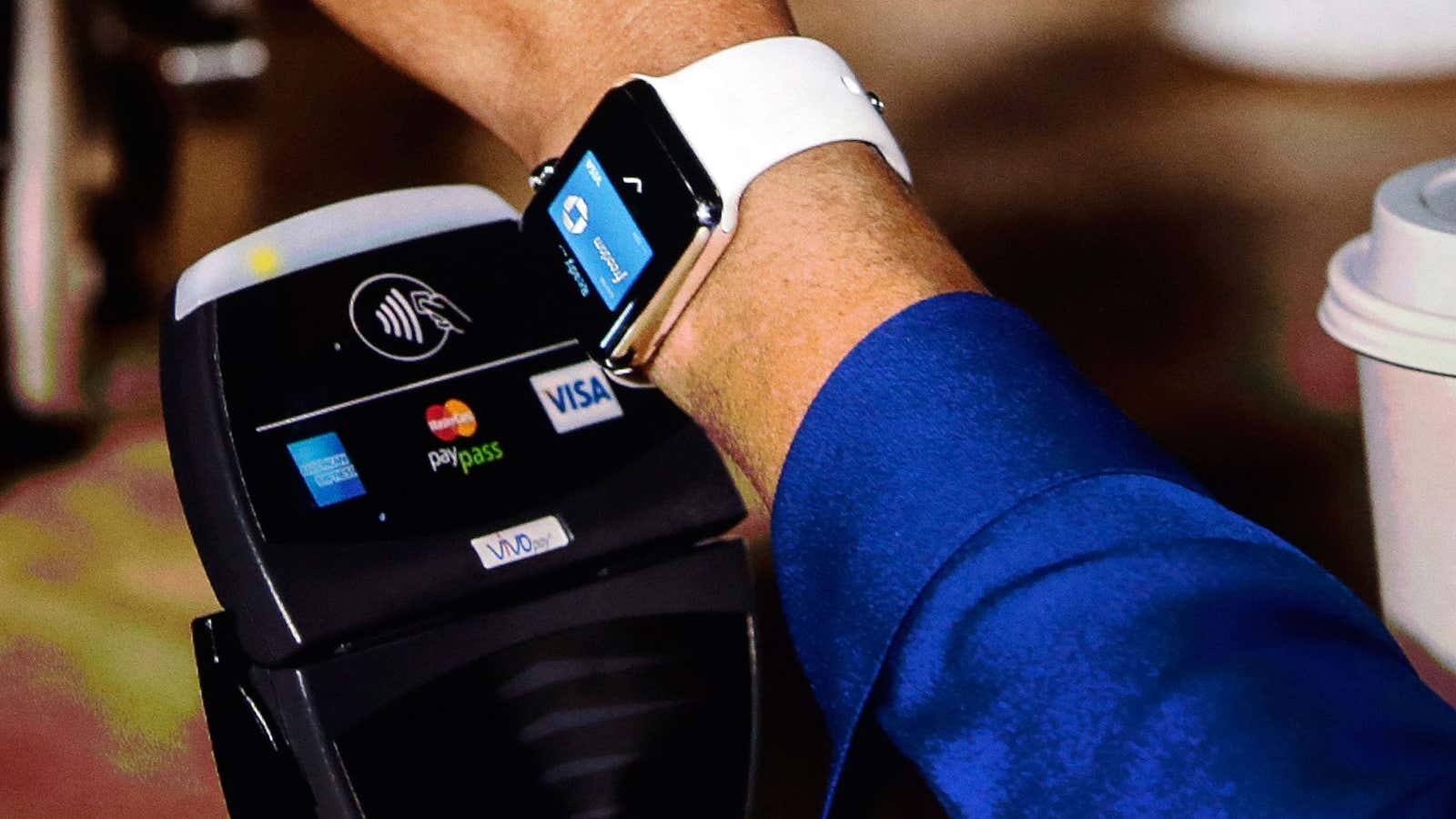When Google first debuted its mobile wallet in 2011, the company tried to sell consumers on its vision for a future free or credit cards. Given how glued people were to their mobile devices, it seemed logical that they would ditch plastic and choose instead to pay by tapping their phones.
That future has not materialized.
The dream, though, is very much alive. In a matter of months, the mobile payments sector suddenly got a lot more crowded with tech giants. Last fall, Apple launched its payments technology, Apple Pay—within three days, it had 1 million credit cards on file. PayPal became a thorn in Apple’s side by acquiring Paydiant, the startup that powers the technology behind Apple Pay competitor CurrentC.
At Mobile World Congress this week, Samsung showed off Samsung Pay, which reportedly will work with 90% of existing credit card readers, thanks to technology from its recent acquisition of LoopPay. Though Google hasn’t shown all its hand yet, it’s in the process of rebooting Google Wallet, recently striking deals with wireless carriers while also acquiring assets from Softcard, once a competing solution from the carriers. Google has also hinted at a new technology called Android Pay, set to debut in the coming months.
And if the upcoming Apple Watch proves a commercial success, it’ll help open up Apple Pay to a wider base of consumers because the smartwatch is compatible with iPhone 5 models or later.
These recent plays show a lot of enthusiasm for mobile payments, but don’t reflect shifting consumer habits. In the past three months, only 3% of American smartphone owners have used a mobile wallet in stores, according to a Forrester report released in February.
Fact is, credit cards are incredibly simple to use, and even data breaches haven’t deterred consumers, according to industry analysts. “Even when you have a good technology, the payment experience is at best as good as cash and card payment,” Gartner analyst Sandy Shen tells Quartz, noting consumers and merchants have yet to see much added value with payment by phones (and soon smartwatches). “Most of the wallet products on the market today failed to address this issue, and focus more on the technology, and that includes Apple, Google, and Samsung.”
As it stands, the current landscape is far from that best-case scenario. Apple Pay’s success hinges on merchant acceptance, and it has encountered roadblocks with retailers backing competing solutions, such as CurrentC.
Forrester’s Sucharita Mulpuru-Kodali likens the battle for mobile payments to the one that played out between Blu-ray and HD DVD in the early 2000s. “You have competing formats fighting to win, and it becomes a reason for market paralysis,” she says. “There will be [Near Field Communication] versus EMV [chip cards] versus barcodes versus the old-fashioned mag stripe versus others.”
Each format also brings with it security concerns, she notes. Apple and Samsung are trying to assuage consumers’ fears by highlighting their safety measures, such as tokenization (so merchants receive a one-time use token instead of full credit card information) and fingerprint readers.
But recent news of fraud on Apple Pay—not caused by Apple’s infrastructure but a shortfall in banks’ verification process—is reviving some of those fears. Magnetic Secure Transmission, the technology that lets existing credit card readers accept Samsung Pay, is also raising some red flags because it relies on legacy technology, the magnetic stripe, as the credit card industry pushes for NFC and chip cards complaint with EMV (Europay, MasterCard, and Visa) standards.
“There is going to be a quick out-of-the-gate advantage to Samsung because of the [Magnetic Secure Technology] component,” says David Robertson, publisher of payments research publication the Nilson Report. “But I don’t see a lot of enthusiasm in the Visa and MasterCard [both Samsung Pay partners] responses on the MST part. They’re looking at the NFC part because that’s where the future is going.”
But to win shoppers over—and keep them coming back—companies will need to make paying by phone (or watch) as seamless as possible, and it needs to work every time. Some analysts believe Apple’s already achieved this with its technology, but the same can’t be said of its competitors.
On the iPhone 6 and 6 Plus, Apple Pay requires users to scan their fingerprint while holding the device near a compatible credit card terminal. Samsung Pay, however, adds a few extra steps, according to early demos, requiring users to swipe up from home screen to launch the app, choose a credit card, scan their fingerprint, and then tap to pay. ”How would you like to stand in line at the check out if everyone has a Samsung device?” asks Roberson.




